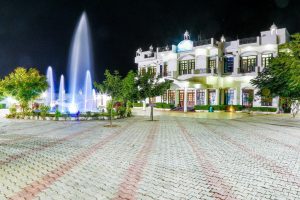Saurabh Tankha
If you are watching the re-run of the Mahabharata on DD Bharati these days, you will find the Pandava brothers along with wife, Draupadi, at Viratnagar, spending agyatvaas or the year of hiding after completing 12 years of vanvaas or exile. This was after Indraprastha ruler Yudhishthir had lost the game of chausar to the Kauravas and accepted the pre-conditioned promise of 12 years of exile and an additional year of hiding.
It was almost a year back that I had chanced upon this hidden land when I had accompanied my cousin, Ishan, to his to-be-constructed farmhouse, around 200-odd km from the National Capital on NH48, nearer to the Pink City of Jaipur. Nestled in picturesque Aravallis, we reached this place after taking a left turn from Bhabru on way to Jaipur from Delhi and cover another 25 km further inside. As Ishan had finalised the deal recently, we put up at Hotel Gulmohar Sariska, around a kilometre from his place for the night. It was in the Explore The Unexplored guide of the sightseeing sites during dinner that I found we were in Viratnagar, amid history.

Ancient Viratnagar, once known as Bairath, I found dated back to the times of the Mahabharata and was the capital of Matasya king, Virat. The Pandavas had spent the 13th year, the one of hiding here. In fact, Bheem, one of the five Pandava brothers, killed the commander-in-chief of Matsya kingdom, Keechak, in Viratnagar after he allegedly molested Draupadi who worked Sairandhri, a female servant, in the palace.
This ancient and uncharted attraction also has Beejak Ki Pahari, an unexplored site, hardly visited by anyone. I only had the company of my cabbie, Niranjan, on this trip as we struggled on a hot and sultry afternoon to reach the top of the hillock with an extremely steep climb. En route, I recalled the warning the hotel receptionist gave us, “Despite the authorities having constructed a cobbled pathway, this exploration would be tough. So, be careful.” My cousin took the advice seriously and chose to stay at the hotel. Viratnagar has strange, naturally formed rocks and boulders which resemble human or animal skulls. On whether these were created by humans or are natural is yet to be researched.
However, I must admit the ascend was worth every step taken as there awaited this historical wonder – remnants of a couple of Buddhist monasteries. It is believed eight such monasteries were in existence when Chinese explorer-monk-scholar Hiuen Tsang’s visited Viratnagar in 634 AD, around 900 years after Emperor Ashoka’s first visit to this place. The place also has two Asokan inscriptions and important ancient Buddhist relics have been found here.
So, when the Coronavirus is finally defeated and evaporates from the face of the earth, I suggest you plan a trip to Viratnagar and experience history first hand.
WHAT NOT TO MISS WHEN IN VIRATNAGAR
Bijak-Ki-Pahadi
Witness the remains of Buddhist monasteries. Lower central part of the platform is a circular chamber which resembles a temple in view. It is said to be the oldest temple in the vicinity. Buddhist scriptures on the exterior walls of the temple were built during the reign of King Ashoka whose inscription is also there on Bijak-Ki-Pahadi.
Bheemlata Pawan Dham
Dates back to the times of Mahabharata. A hill made up of huge rocks. The hilltop has a Hanuman Temple. Famous for its 6ft Shivalinga.
Mughal Gate
Built by Mughal emperor Akbar who used to visit Sariska from Agra for hunting. Apart from being his hunting lodge, it was also used as the Diwan-i-Am.
Jain Nasiha
Situated opposite Mughal Gate, this structure too belongs to the Mughal era and was used as Diwan-i-Khas. It was later gifted to one of Akbar’s nine gems – Todarmal Jain. Has been restored by the Jain community and has an art gallery with paintings from ancient times.
Ganesha Temple
Dates back from the period of Mahabharata and considered as the spot where Pandavas conducted victory prayers right before embarking on the battle with Kauravas. It is believed the idol of Lord Ganesha is a consequence of rocks taking shape naturally without any human intervention.
Mansa Mata Temple
Dedicated to a form of Shakti, Mansa Devi Temple holds significant value by virtue of being the 52nd of the 56 Shaktipeeths (seats of power) as per the Hindu mythology.
Kuntunath Temple
Said to be more than seven centuries old and dates back to the times of Persian ruler Mohammad Ghazni. Huge following among Shwetambar sect of Jain community.
DISTANCE
From Delhi: Around 200 km
From Jaipur: Around 90 km
From Alwar: Around 65 km
From Sariska Tiger Reserve: Around 40 km